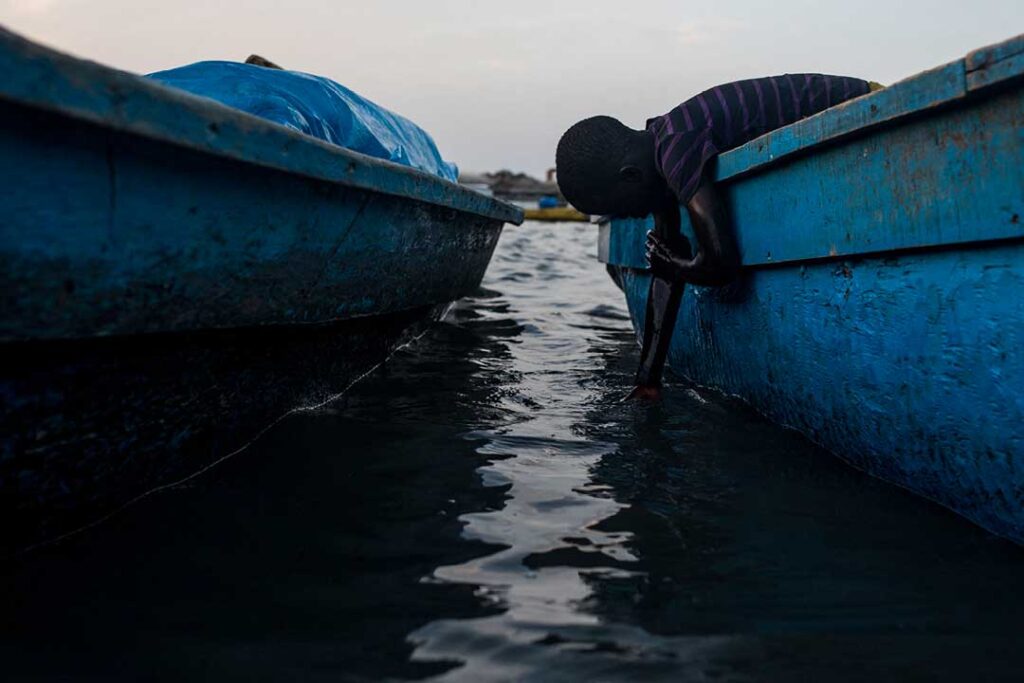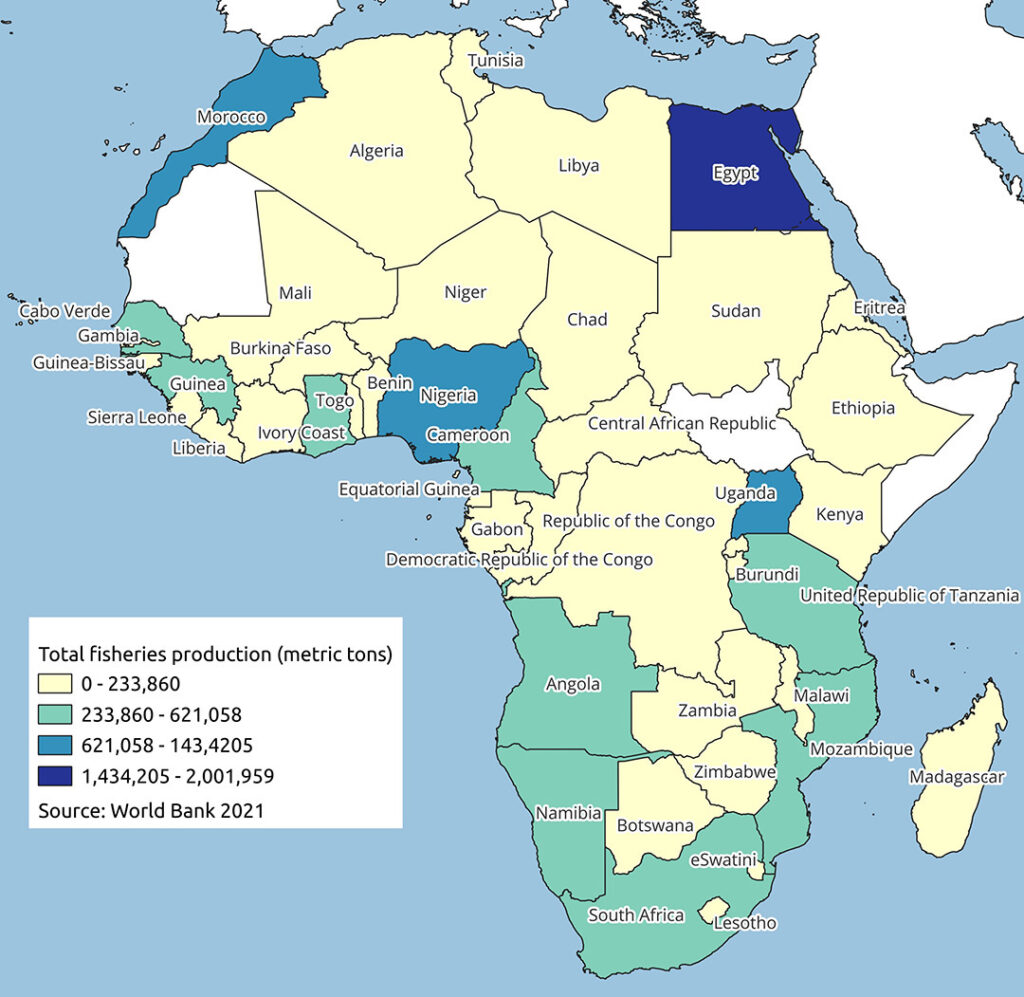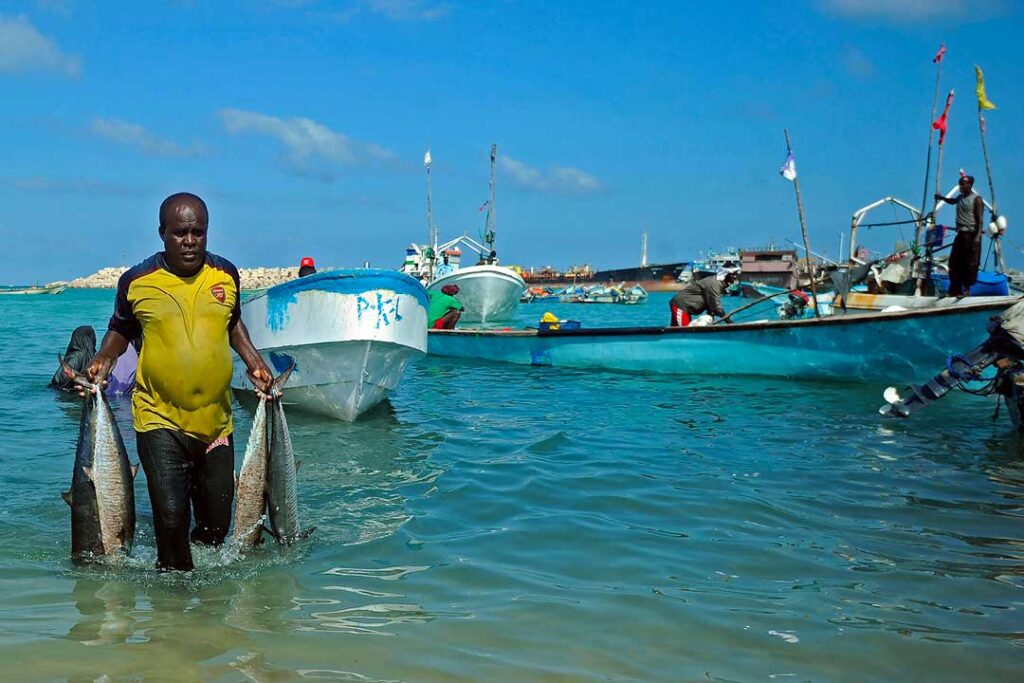Finding a balance between preserving fishing resources and providing adaptation strategies to fishery-dependent households is complex and difficult. Most of the strategies employed by government institutions focus on ecological adaptation and the sustainability of resources, which can often undermine the capacity of fishery-dependent communities to adapt to climate change and the impacts of overexploitation. Fishing remains a critical source of livelihood for millions of coastal residents across East and West Africa; without it, millions face severe food insecurity.
The coastal regions of sub-Saharan Africa (SSA) are well-endowed with great cultural, ecological, and climatic diversity. Africa’s western and eastern coastlines stretch across a combined 10,100 km and encompass some of the most diverse fish resources in the world.

However, Africa’s fishing sector, which in 2011 contributed an estimated $24 billion annually to the region’s economy, faces serious long-term threats, not only from climate change but from overfishing, and poor management of the aquaculture system as well. Across SSA, some 100 million citizens depend on fisheries as a primary or alternative livelihood activity, and rising populations and per capita income growth are expected to increase the demand for fish by 30% across the continent. However, despite the sector’s great potential, it underperforms in production and supply. Although data for the entire SSA region remains limited, some substantive research has been done to deepen our understanding of the region’s vulnerability to climate change impacts on marine fisheries.
Within the past decade, food insecurity has risen in SSA countries; recent statistics indicate an estimated 704 million people experience moderate to severe food insecurity. Around 30% of the SSA population depends on fish and fish products as their primary source of animal protein.

The latest Intergovernmental Panel on Climate Change (IPCC) report, released in March this year, indicates that “widespread and rapid changes” have occurred in the earth’s geosphere and hydrosphere (i.e., oceans, rivers, and lakes). Fishing communities have been identified as among the most vulnerable to climate change due to their high dependence on climate-sensitive resources. Not only that, but together, fisheries and humans form a complex social-ecological system that is under threat from both human exploitation and climate change. Climate change causes ocean acidification, increasing sea surface temperatures, lower PH levels, sea-level rise, and more intense cyclone systems, amplifying other stressors like pollution, overfishing, and illegal fishing.
Aquatic species and organisms exhibit diverse responses to shifts in climate conditions. These changes can prompt shifts in a species’ distribution, dynamics, physiology, and seasonal biological patterns. For instance, elevated temperatures can significantly influence fish reproduction, development, and metabolic functions. In southern Africa, sea surface temperatures are rising at an accelerated rate of 0.8 °C per decade, surpassing the global average. Projections indicate that coastal areas in both the western and eastern parts of Africa could experience a temperature surge of up to 3°C by 2100. Furthermore, the foreseeable future is likely to witness a heightened frequency and intensity of extreme weather events, such as intense rainfall and prolonged droughts. The effects of climate change on fisheries can be broadly classified into biological, physical, and socioeconomic impacts.

The effect of climate change on the biology of certain fish and aquatic species is a key concern among scientists. Plankton, the foundation of the aquatic food web, is sensitive to changes like temperature and rainfall. Studies have examined whether plankton’s abundance is at risk in freshwater and marine ecosystems and found that, for example, in East Africa’s Lakes Kivu and Malawi, there is a diminishing population due to warmer water. Fish reproduction is also closely linked to specific temperature ranges due to its impact on cueing egg production, larval distribution, and survival. Effects differ among species, but studies indicate that temperature changes have caused some fish species to migrate to new areas with more favourable conditions.
Rising sea levels, a prominent consequence of melting ice and diminishing snow coverage, stand as one of climate change’s most widely recognised outcomes, with its impact on coastal fisheries and vulnerable island nations taking centre stage. While understanding sea-level change across the coastal regions of sub-Saharan Africa (SSA) remains a challenge, recent strides have been made in investigating its ramifications along the shores of Accra, Ghana. This research aims to discern the effects on fish distribution, coastal habitats, and essential infrastructure. The findings underscore the sobering reality that, over the long term, 100,000 individuals could face displacement, while the Desu wetlands – a critical natural fish landing site for small-scale fisheries – are in peril of inundation. The repercussions extend further; vital habitats like mangroves, seagrass beds, and coral reefs – crucial sanctuaries for breeding, nurturing, and feeding – are at serious risk across the coastlines of SSA.
The capacity of many coastal communities and their governments to cope with these impacts is limited, but there are strategies that scientists and policymakers have proposed to help them.
A solid grasp of the ecological roles, socioeconomic dynamics, and institutional settings within a specific fishery or aquaculture system should form the foundational elements essential for enhancing resilience and formulating the most suitable adaptive strategies. These strategies vary depending on the location and available resources. Diversifying livelihoods, changing fishing gear, targeting new species, and relying on social networks are among the strategies fishery communities can employ.

Fishers in Lake Wamala, Uganda, for example, changed their fishing gear, increased fishing time, targeted new species, and diversified to non-fishery livelihoods. In Kenya, changing fishing gear has allowed fishers to catch new species and increase their catch per unit effort. In West Africa, small-scale fishers have increased their efforts and expanded their fishing grounds. In West Africa, there has also been migration to new fishing grounds within Exclusive Economic Zones (EEZs). This strategy has helped fishers who have experienced declines in traditional catches due to climate change to target previously unexploited fish species. However, some of these strategies are beneficial in the short term but can risk overexploitation and increasingly unsustainable fishing practices in the long term. For example, in Lake Wamala, fishers changed their fishing gear by reducing the mesh size, which is likely to result in heavy exploitation of non-target species and younger juvenile fish.
The capacity of communities to adapt to climate change depends on institutional regulations and interactions. Institutions play a crucial role in fisheries management and conservation for sustainable development. However, institutional approaches often prioritise ecological adaptation over the adaptation capacities of fishery-dependent households and communities. This can have socioeconomic impacts, such as the exclusion of fishers from marine resources. Fishing boundaries can also hinder the ability of small-scale fishers to adapt to climate change. In Senegal, livelihood diversification has helped yield dual benefits for food security and poverty reduction. This has included training and assisting women’s collectives in establishing new oyster farms. Further afield, a project in the South Pacific island nation of Vanuatu is aiding coastal communities in cultivating ecotourism. Certain initiatives encompass business development and planning training, facilitating a shift to livelihoods that decrease dependency on potentially fragile ecosystems, such as mangrove or coral reef habitats.
Adaptation ought to be seen as a continuous and evolving journey, integrating adaptability and input loops to glean insights from previous encounters and prevent emerging threats. For now, further investigation is necessary to evaluate the efficacy of adaptation methods for fisheries and aquaculture across the coastlines of SSA.


